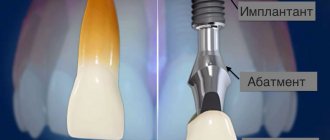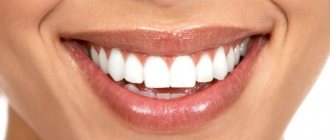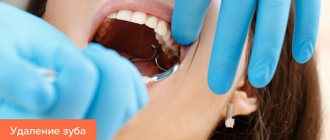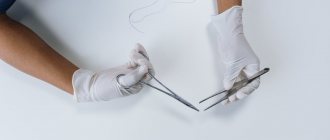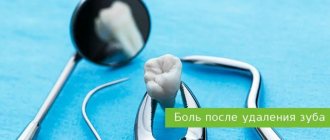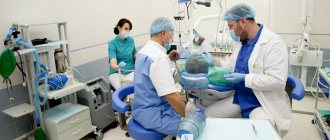28.10.2019
Removing or extracting a tooth is an unpleasant procedure. After the operation, tissue healing awaits. How many days will it take for the sutures to be removed from the gums, what can and cannot be done before and after removal of the sutures - such questions torment patients.
Content:
- Why is the wound sutured after pulling out the figure eight?
- Classification of seams
- How long do you need to walk with non-absorbable sutures?
- How long does it take for self-absorbable sutures to dissolve?
- What complications can you encounter after suturing?
- Recommendations for patients
A dental surgeon applies sutures after removing a wisdom tooth if the intervention was very complex and serious injury to the gums occurred.
Often, specialists insist on suturing a wound, even if it is small, in order to minimize the likelihood of infection. Let's consider what material doctors use when suturing after tooth extraction, whether it needs to be removed in the future, and how to properly care for the injured area.
Antibiotics and other medications after dental implantation
Antibacterial drugs are prescribed to prevent the development of infection. Some doctors believe that you should only take antibiotics if you are at high risk, for example, if your immune system is reduced, you have chronic diseases of the upper respiratory tract, periodontitis, or you have had several implants installed at once. However, many dentists insist on the need for antibiotic therapy.
For the purpose of prevention, broad-spectrum drugs are prescribed: penicillins, cephalosporins. The doctor can prescribe any available drugs: Lincomycin, Amoxiclav, Flemoxin, Tsifran ST. Antibiotics must be taken strictly according to the schedule, in the appropriate dosage.
To prevent or relieve inflammatory processes, ointments or gels for external use are prescribed: Metronidazole, Solcoseryl. The latter drug improves metabolic processes in tissues and promotes rapid healing of wounds.
In the first weeks of the rehabilitation period, it is recommended to rinse your mouth after eating with antiseptic solutions: Chlorhexidine, Miramistin and their analogues. You can prepare decoctions of medicinal herbs: oak bark, chamomile, calendula, sage.
Why is the wound sutured after pulling out the figure eight?
Wisdom teeth are very insidious and often lead to serious problems. Pulling it out most often resembles an operation. Since the roots of the unit go deep into the gum and can be ornate, tortuous, soft tissue is often excised to extract them. After all solid debris has been removed from the depths of the tissue, the wound is sutured. This is done in order to:
- prevent bleeding;
- protect the blood clot formed in the wound from injury;
- protect the operated area from the accumulation of food debris;
- minimize the risk of damage to the operating area;
- speed up regeneration processes.
It is believed that applying sutures after wisdom tooth removal reduces the likelihood of infection by approximately 90%. This is explained by the fact that pathogens cannot penetrate into the deep layers of the wound.
Why are sutures required after wisdom tooth removal?
Extraction of the third molar requires suturing. It is not always possible to save the patient from the procedure described above. Even when working with high-quality equipment, a competent dentist will encounter problems. The third molar is secured with the help of two roots, the removal of which requires making a few incisions, and then removing the tooth body from the gum. Sutures are also applied if there are clinical signs of gum inflammation. Swelling is considered a natural process for the body, due to damage to the gums during incisions. The suturing procedure is also a preventive measure, which reduces the risk of infectious pathological syndrome; pathogenic bacteria do not penetrate into the open wound. The smaller the size of the wound, the lower the likelihood of infection, the age the rate of regeneration. Regardless of the type of thread used, suturing takes a short period of time. Self-absorbable threads are a more preferable option; they do not need to be removed and re-injure the gums.
Classification of seams
After tearing out the “eight”, at the discretion of the dental surgeon, regular and self-absorbing sutures can be applied.
In the first case, we are talking about materials that cannot dissolve on their own. These are silk, nylon, polyester. Such threads are not absorbed. They securely hold the edges of the wound until the doctor removes them. Self-absorbable material is absorbable. Its main advantage is that the patient does not have to visit the doctor again to have his stitches removed. The latter disappear without a trace on their own.
There are two types of self-absorbable threads:
- Absorbable due to hydrolysis reaction. These include Dexon and Vicryl threads. They are synthetic and do not cause allergic reactions. The edges of the wound are securely held for about one month.
- Absorbable due to the influence of enzymes. We are talking about Catgut. Its particles are quickly eliminated from the human body. Catgut is used for complex dental operations. But it is important to consider that it contains foreign proteins that can cause inflammation.
There is no need to think that suture materials dissolve without a trace. They simply break down into tiny particles that a person spits out or swallows. These particles are non-toxic and therefore cannot cause poisoning.
Types of seams. Types of threads
In each case, when the dental surgeon sutures the gum, he decides which suture to use.
Seams can be intermittent or continuous.
The first type is more common and is characterized by the overlapping of separate, unrelated stitches (pictured below), and each is secured with its own knot.
This maintains the integrity of the fabrics, even if one of the stitches fails and falls off.
There is continuous suturing. All stitches are made with a single suture thread, securing them with a common knot. It's faster, but any damage to one stitch can ruin the entire thread construction.
Absorbable and non-absorbable threads are used to suture the gums.
Sutures that dissolve
Natural (Catgut) and synthetic (Vicryl, Dexon) threads are used. When suturing the gums with Catgut, it can stay on the wound for at least 2 weeks. It is dissolved by saliva substances, but due to its protein base it often causes allergies with inflammation of the gums.
Catgut is contraindicated if there is a high risk of inflammatory complications. Dental surgeons are using this material less and less.
Synthetic Vicryl is safe in terms of tolerability, adheres tightly to the gum, and does not change its strength properties during disinfection. If the doctor does not prescribe a time limit for removing the threads, they will still dissolve within 3 months.
Dexon will last on the gums a little longer than Vicryl, otherwise their properties are similar.
No one can say for sure how long it takes for threads to dissolve in a particular patient. This depends on individual factors: characteristics of the wound, the chemical environment of the oral cavity, general immunity, and the patient’s hormonal status.
When absorbed, the thread does not disappear without a trace, but gradually disintegrates into particles, which are spat out or swallowed by the patient. It is not dangerous to health.
Threads that do not dissolve
Non-absorbable threads are nylon, silk, polyamide fiber (nylon). Synthetic threads are completely hypoallergenic.
Sutures made from non-absorbable sutures are called non-absorbable or non-absorbable sutures. Their removal after the stitches have healed is mandatory. If such threads are used and there are no complications, the surgeon will release the patient from them 7–10 days after the tooth has been pulled out or another operation on the gums has been performed.
How long do you need to walk with non-absorbable sutures?
If the doctor used non-absorbable suture material after removing a wisdom tooth, then seven to ten days later the patient must return for an appointment. The doctor will evaluate how the wound is healing and determine whether the suture material can be removed.
There is no need to be afraid of this procedure. It causes only minor discomfort. The dentist cuts the stitches one by one and, grasping one end of the thread with tweezers, carefully pulls it out. If the patient is afraid of pain, the doctor may use topical anesthesia.
Why do headaches occur after dental implantation?
Surgery is accompanied by various ailments, including headaches. This is due to the activation of the body's immune system. In some patients, along with pain, body temperature rises.
Normally, the head may hurt for three days. At this time, you need to take painkillers. If the symptom persists for more than four days, it may indicate inflammation around the implant or an allergic reaction to metals.
If, in addition to pain in the mouth, there is a metallic taste, bitterness, sleep is disturbed, and constant weakness is felt, then you should consult a doctor.
How long does it take for self-absorbable sutures to dissolve?
Typically, the suture material disintegrates after three weeks. The patient may notice how it has fallen out, or simply find that the wound remains clean, without threads. In more detail, catgut dissolves from ten to fourteen days, Vicryl - within thirty days, Dexon - a little longer.
It is impossible to name the exact period of resorption. Here everything depends not only on the characteristics of the material used, but also on the individual characteristics of the patient’s body. It also happens that the threads are still in place, but the doctor no longer sees the need for them. Then he removes them in the same way as non-absorbable ones.
What affects the timing of suture removal?
Gum healing sometimes occurs with peculiarities. The rate of tissue regeneration is influenced by the following factors:
- patient's age;
- the presence of chronic diseases;
- bad habits that persist after implantation;
- volume of surgical intervention.
Healing time may be delayed if a person has diabetes or smokes. In this case, the stitches are most often removed after two weeks.
The date for removal of the suture material is determined by the dentist. It is important to come on the specified day, since performing this procedure late may lead to undesirable consequences.
What complications can you encounter after suturing?
- As a rule, the regeneration process proceeds without complications. But it happens that the patient encounters symptoms that bother him. Let's name the most common complications after wisdom tooth removal:
- Bleeding. In the first three days after surgery, periodic bleeding is considered normal, but if bleeding persists longer, you should immediately consult a dental surgeon.
- Three days after removal, the gums look very swollen and very painful. You need to make sure that all roots have been removed. To do this, pictures of the inflamed area are taken.
- Increased temperature several days after surgery. If the hole bleeds, is swollen and hurts, and the body temperature is elevated, we can talk about inflammation of the surgical area. To remove it, you need to carry out antibiotic therapy.
If you have the slightest doubt regarding the healing process, you should immediately see a qualified dentist. Very often, delay makes the situation worse. It is better to get a consultation once again than to treat an advanced complication for a long time.
Recommendations for further gum care
In a broad sense, dental implantation is not completed after the sutures are removed. The postoperative wound heals completely only after three to four weeks. The artificial root is overgrown with bone tissue within several months. And only after the completion of the regeneration and osseointegration processes can we say that the implant is securely installed and can be loaded with a prosthetic structure.
After removing the sutures from the wound, you should follow the dentist's recommendations. In particular, it is important:
- after eating, rinse your mouth with disinfectant solutions;
- brush your teeth with care, without touching the implantation area;
- Until the wound is completely healed, do not neglect regular oral hygiene.
Compliance with the doctor’s prescriptions and recommendations helps the patient go through the first part of the rehabilitation period without complications.
Recommendations for patients
To ensure that the recovery process takes little time and goes without complications, it is recommended:
- Follow all doctor's orders.
- Do not eat anything for the first few hours after surgery. In the first two to three days after therapy, chew food with the healthy side of the jaw and give preference to soft foods.
- Do not touch the unhealed hole with your hands.
- Do not try to remove a blood clot with your tongue or foreign objects.
- Rinse only if prescribed by a doctor.
- Avoid strenuous physical activity for the first two weeks.
- Do not attempt to remove stitches yourself.
By following these simple rules, a person can quickly return to their normal lifestyle after dental surgery.
What else do patients ask about after implantation?
Since the installation of implants is a surgical operation, people are interested in many questions about the rehabilitation period.
- Does it hurt to remove stitches? The procedure is carried out after the wound has healed, so removing thin threads does not cause pain. If the patient experiences severe fear, the doctor may treat the suture area with an anesthetic gel or spray.
- Why is smoking prohibited after implantation? Nicotine constricts blood vessels, slows down metabolic processes, and impairs tissue nutrition. This negatively affects wound healing and implant healing. If the patient cannot quit smoking for a long time, the doctor has the right to refuse surgery.
- Why is Dexamethasone prescribed after implantation? The drug can be used as a powerful pain reliever. If the risk of inflammation is very high, then Dexamethasone is prescribed along with antibiotics. The drug quickly stops inflammatory processes and alleviates acute symptoms.
- How long does a tooth hurt after implant placement? Painful sensations persist for 3 - 5 days. If the pain is severe, you can take painkillers.
Is it possible to remove stitches yourself?
Of course, it is undesirable to remove stitches without a specialist: if you do it carelessly, you can cause an infection or open the wound ahead of schedule. But in some cases this is acceptable.
Things to consider:
- Do not remove the metal staples yourself, as you will not be able to do it anyway. Only a specialist can properly remove staples from the skin without harming the patient.
- You can remove stitches yourself only from small wounds; you should not remove threads after major operations yourself.
- Do not wet or wash the stitched areas with soap unless your doctor asks you to do so.
- This procedure is painless, so you have nothing to fear. However, if you feel pain, you should immediately report it to your doctor.
